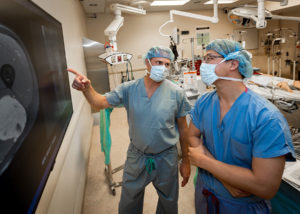
Communication breakdowns and poor teamwork are major contributors to preventable patient harm during surgery. To combat these and other threats to patient safety, surgical teams at Brigham and Women’s Hospital have long been provided with training that simulates crises in the operating room (OR). The proactive nature of these simulations is something that the Brigham’s Division of Urology finds invaluable.
“In a crisis situation, the entire team needs to be rapidly mobilized in the OR to provide an effective solution,” says Adam S. Kibel, MD, chief of Urology at Brigham and Women’s Hospital. “We need ways to improve our group effectiveness for these rare but critical events.”
The program was initially proposed by CRICO, the malpractice insurer for the Harvard medical community’s clinicians and organizations. CRICO’s reasoning was that the training would enhance the ability of OR teams to respond to real-life crises and thus reduce the risk of poor outcomes.
“CRICO asked if we could do team training for full OR teams in a simulated environment,” said Douglas Stewart Smink, MD, MPH, a minimally invasive general surgeon at the Brigham who has taught the course since its inception. “They wanted us to figure out how to train surgical teams and not just surgeons themselves because they know we don’t work in a vacuum—we work as part of a team.”
Accordingly, teams undergoing training typically include surgeons, anesthesiologists and OR nurses, all from the same discipline. The program is run on a three-year cycle, and time in training for each individual totals five hours. Along with the Brigham, three other Harvard-affiliated hospitals participate.
A Response to Increasing Hecticness
Training is designed to highlight clinical scenarios that are common in a particular specialty. For instance, urologic teams might take part in a simulated nephrectomy or removal of a retroperitoneal lymph node, just as they often do in the OR.
However, the primary focus isn’t on technical skills. Rather, instructors develop intense crisis situations that put learners’ communication and teamwork skills to the test.
“Our systems today are more complex, and our teams are constantly changing throughout a procedure and throughout the day,” Dr. Smink said. “The days of a surgeon working with the same scrub technician, nurse and anesthesiologist every time they operate are long gone. And so we need to teach everybody in the OR these important skills.”
Another current point of emphasis is patient safety. “With our days being so hectic, it’s critical to guard against safety threats around things like imperfect information, EMRs and wrong-site surgery,” Dr. Smink said. “So we reinforce the importance of the safe surgery timeout, for example, because there are a lot of data saying that you need to be trained and retrained to do it properly.”
Noting its potentially disruptive impact on team dynamics, Dr. Smink added that urologic robotic surgery—in which the surgeon is separated from the rest of the team—could be an area of exploration for future training.
“The lesson of working together applies to all OR crises, but improved focus on particular events with specific issues can only help prepare us for the eventual untoward event,” agrees Dr. Kibel. “We have reviewed how we would manage adverse robotic events, and the time has come to simulate those management strategies to see how effective they would be.”
Lessons Learned
Having led OR team training for nine years, Dr. Smink had several pieces of advice for other hospitals looking to implement similar programs.
First, faculty leading the training must be skilled and experienced in teaching a group of practicing clinicians and nurses. Each of the three simulated cases comprises about 20 minutes doing the case and about 40 minutes discussing it afterwards. The faculty’s job is to lead the debriefing and pull out the most vital concepts.
Second, Brigham conducts training at the STRATUS Center for Medical Simulation, one of the world’s most comprehensive and technologically-advanced medical training centers. However, Dr. Smink said, a hospital doesn’t need to have such a sophisticated simulation facility in order to teach the essential skills. “I think most places could do this,” he added.
Finally, while CRICO reduces malpractice premiums by 10 percent for participating surgeons at the Brigham, merely offering financial incentives isn’t enough. “You need to have a culture where participation is expected,” Dr. Smink concluded. “That means buy-in not only from hospital leadership, but also surgeons, anesthesiologists and nurses.”